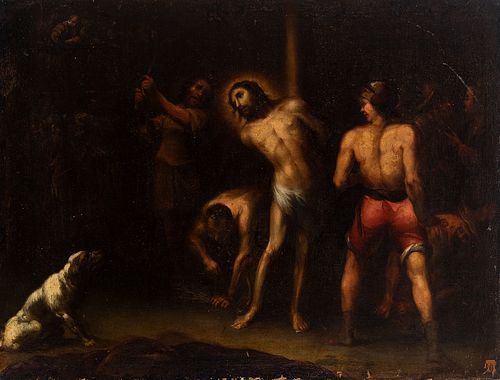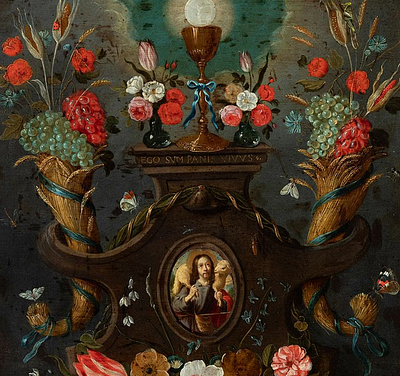Sevillian school; second half of the 17th century. "The flagellation". Oil on canvas. Re-drawn.
Lot 17
About Seller
Setdart Auction House
Carrer Aragó 346
Barcelona
Spain
Setdart Subastas was born in 2004 and is currently the first online art auction in Spain with solidity, prestige and reliability guaranteed by our more than 60,000 users. Setdart has a young, dynamic and enterprising team ready to successfully manage the purchase and sale of art works through custom...Read more
Estimate:
EUR€3,000 - EUR€4,000
$3,157.89 - $4,210.53
Absentee vs Live bid
Two ways to bid:
- Leave a max absentee bid and the platform will bid on your behalf up to your maximum bid during the live auction.
- Bid live during the auction and your bids will be submitted real-time to the auctioneer.
Bid Increments
| Price | Bid Increment |
|---|---|
| EUR€0 | EUR€10 |
| EUR€200 | EUR€25 |
| EUR€500 | EUR€50 |
| EUR€1,000 | EUR€100 |
| EUR€3,000 | EUR€200 |
| EUR€5,000 | EUR€500 |
| EUR€10,000 | EUR€1,000 |
| EUR€20,000 | EUR€2,000 |
| EUR€50,000 | EUR€5,000 |
About Auction
By Setdart Auction House
Sep 21, 2021
Set Reminder
2021-09-21 10:00:00
2021-09-21 10:00:00
America/New_York
Bidsquare
Bidsquare : 21st September - ARAS JÁUREGUI Private Collection - Old Masters, 19th & 20th Century
https://www.bidsquare.com/auctions/setdart-auction-house/21st-september---aras-j-uregui-private-collection---old-masters-19th-20th-century-7429
Setdart Auction House sofia@setdart.com
Setdart Auction House sofia@setdart.com
- Lot Description
Sevillian school; second half of the 17th century. "The flagellation". Oil on canvas. Re-drawn. It presents faults and repainting. Measurements: 75,5 x 99 cm. Related to the schools of Murillo and Valdés. As for its iconography, the four Gospels mention the punishment that Christ suffers in this moment, although they do not make reference to any column: this iconography comes from the word "punishment" that Luke uses, and it was known as a moment previous to the Crucifixion. Throughout the Middle Ages the column venerated in Jerusalem was used for these representations, characterised by its height. There is another typology, however, which closely follows the model of the relic preserved in Santa Praxedes in Rome since 1233 and which the Council of Trent was responsible for recovering for art, characterised precisely by the marble in which it is made and by its low height. This model of column, which does not negate the previous one in that theologians recognise two moments in which Christ was scourged, was used in art from the end of the 16th century and spread rapidly throughout Europe. In this scene Christ is tied to the pillar and is in the centre of the composition, accompanied by three other figures who observe and participate in his torment. One of them is wearing a helmet, thus identifying him as a Roman soldier, another is crouching down, and finally the third, on the left of the composition, makes the gesture of raising the whip, which falls on Jesus' skin. The scene is notable for its dramatism, which stems from the subject matter but is reinforced by the artist's use of Tenebrist lighting, in which only the bodies have warmth, in contrast to the darkness that envelops the scene. It is worth mentioning the anecdotal element that relieves the work of the aforementioned expressive tension: the dog. This character contemplates the scene peacefully, without any trace of disturbance, only paying attention to the suffering of Jesus. The 17th century saw the arrival of the Baroque in the Sevillian school, a style that would reach its full maturity at the end of the century and also throughout the 18th century. With the new style came the triumph of naturalism over Mannerist idealism, a loose style and many other aesthetic liberties. At this time the school reached its greatest splendour, both in terms of the quality of the works and the primordial status of Sevillian Baroque painting. Thus, during the transition to the Baroque period, we find Juan del Castillo, Antonio Mohedano and Francisco Herrera el Viejo, whose works already display the rapid brushstrokes and crude realism of the style, and Juan de Roelas, who introduced Venetian colourism. The middle of the century saw the fullness of the period, with figures such as Zurbarán, a young Alonso Cano and Velázquez. Finally, in the last third of the century we find Murillo and Valdés Leal, founders in 1660 of an Academy where many of the painters active in the 18th century were trained, such as Meneses Osorio, Sebastián Gómez, Lucas Valdés and others.
- Shipping Info
-
In-house shipping available. Please inquire at admin@setdart.com.
-
- Buyer's Premium



 EUR
EUR CAD
CAD AUD
AUD GBP
GBP MXN
MXN HKD
HKD CNY
CNY MYR
MYR SEK
SEK SGD
SGD CHF
CHF THB
THB

















